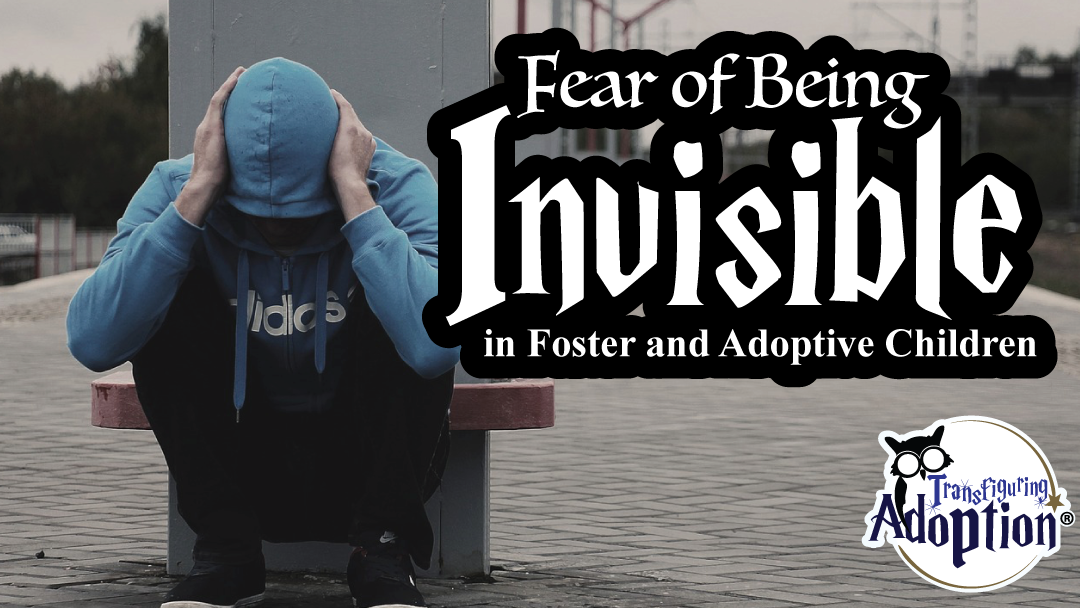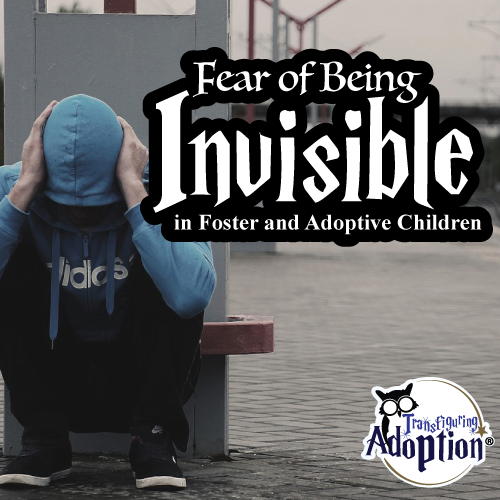Fear drives behavior. If you really think about your motivations for your actions, much of them are deeply rooted in some type of fear. When hearing from experts in foster and adoptive parenting, you will often hear that children’s problematic behaviors are all communicating an unmet need, and much of it stems from fears that are deeply rooted in their subconscious. Why do they hoard food? They have a deeply rooted fear of the past hunger they experienced, whether they remember it or not. There are so many fears that lurk in the minds of children who have experienced trauma.
When reading The A-Z of Therapeutic Parenting by Sarah Naish, I was reminded of one of the most pervasive of these fears, one which drives some maddening behaviors. That is the fear of being invisible (or forgotten). It was interesting that within a couple days of being reminded about this fear, one of my children was relating a story in which something physically painful happened when the child was younger. The child stated that the adults paid some attention, and then said …
“And then I went back to being invisible.”
Whoa! There it was! This child shared a glimpse into an inner thought process. That experience of feeling forgotten and invisible in a previous home created a fear that persists and drives behavior years later.
Children who have been abused or neglected develop this fear often from actual circumstances, and sometimes from perceptions, and every time out of a need to survive. Children are ultimately dependent, especially at a very young age, on adults for survival. Adults provide both the physical and emotional needs of children, and when they fail to do so, children have to fight for their survival.
Behaviors Driven by Fear of Being Invisible and Possible Strategies
Now you may have a foster or adopted child whom you know is safe, whom you know you are providing for and not forgetting, and they are certainly not invisible to you. However, the child does not know, perceive, or feel this on some deep level, or they do not trust that it is a pattern that will continue due to inconsistencies in their past history. These children are afraid of being forgotten, which will ultimately lead to death, so they are going to do whatever they can to make sure you do not forget they are there.
What are some behaviors we have seen as a result? How have we dealt with them? Here are a few examples.
- Nonsense chatter – Children who are afraid of being invisible will talk incessantly. Sometimes it is meaningless strands of words. Sometimes it is questions you know they know the answer to. Sometimes it is a conversation you have had repeatedly. Sometimes it is just obvious statements about what is happening. They may say your name repeatedly to get you to respond and then simply say, “I love you” or “I forgot.” Whatever it is, they just talk from the moment they wake until the moment they go to sleep. I once dropped one of these kiddos off with a very patient person. I had warned earlier that this child asked questions and talked incessantly. The individual responded with a love for the curiosity of children and said that there are no silly questions. A few hours later, I was greeted with a harried look and a comment about how the child really never does stop. I chuckled.
- Incessant Noise – The noises vary from mouth-made noises to just doing everything loudly, especially if the child is in another room and wants to be sure you still hear them.
- Clinginess – Do you ever feel like your child is your shadow? Children who are fearful of being invisible stay in close proximity. If you can’t physically be close, like while on the toilet, they may revert to talking. I hear “I love you, Mom!,” with pauses for my response, all the time while on the toilet or getting dressed.
Lack of Bubble Space – This is closely related to the last one. I have one kiddo who constantly is in other’s space and constantly touching others, particularly caregivers or someone perceived as being able to meet needs for the child. For this child, proximity is not enough. If you are looking at your food while eating, you may just get a finger on your arm. Looking at the pot of boiling water, there may be an unexpected head on your arm or side.
Eight Ways to Answer These Behaviors
These behaviors sound relatively benign. I mean, no one usually gets hurt by these behaviors, right? Until you live them, you may not understand, but these behaviors wear caregivers down to absolutely feeling insane! Here are some of the ways we have dealt with these behaviors:
- Nonsense answers – Darren is known for answering nonsense questions, particularly those that the child definitely knows the answer to, with nonsense answers. His formula is as follows: “Because [color] [animal] [always or never] [activity] on [day of the week].” For example, Darren may say something like, “Because purple cows never blow their noses on Tuesday.” This is playful and fun. The child ultimately gets confused and distracted and giggles. Everyone wins: the child gets engagement, and the adult feels vindicated without being mean or saying, “You already know the answer to that?” for the umpteenth time.
- Playfulness – These behaviors are stemming from fear and anxiety. The more you can respond in playfulness, the more relaxed the child will be.
- Never ignoring – In traditional parenting, we are often told that negative behaviors will disappear if we ignore them, but with children who have a fear of being invisible, ignoring the behavior only confirms their fears and further entrenches the behavior.
- Proximity – Even while doing different activities, it helps children to know you are nearby. You can do computer work while they sit next to you and do homework.
- Physical touch – Physically reaching out to the child frequently helps them know you have not forgotten them. The other day a child was just insatiable at trying to engage me while I was in the middle of reading something important. I was super thankful that I was able to pull the child close, and physically touching the child while I read was enough to help the child regulate and calm the fear. The chatter slowed, though I did have to answer some questions and remind a few times that I was reading.
- Acknowledge the Fear, Name the Need – Sometimes we simply say something that helps the child recognize what they are doing and help them understand that they are not forgotten. A simple, “I am doing my work, but I have not forgotten about you,” or “I love you and won’t forget about you when you are quiet” can go a long way. Reading books that help the child recognize their fears and behaviors can also help empower them to make changes and feel better about themselves. Sarah Naish’s books Katie Careful and the Very Sad Smile and Charley Chatty and the Wiggly Worry Worm are good examples.
- Take breaks! – These behaviors stem from deeply entrenched fears, and even with the most therapeutic parenting, they can continue in some capacity for a number of years. It is important to get a little reprieve however you can whenever you can so that you can respond empathically and not out of frustration and exhaustion.
- Imposing limits – There are always limits. While most of these behaviors are not harmful, they can be dangerous in the wrong context…like that head on your arm while you lift a boiling pot of water. So there are times when we need to create some rules, like no touching or being a shadow to a parent at the stove. And sometimes we need limits just for our own sanity, like “Please don’t touch my arm while I’m eating because I would rather not spill food and have a mess to clean up.”
For more ideas on strategies, I recommend reading The A-Z of Therapeutic Parenting by Sarah Naish to see what methods others have found helpful.
Now It’s Your Turn:
Keep the conversation going. You never know what might help someone else on their journey.
- What are some behaviors you have seen that you think may be caused by this fear?
- How did you respond?

